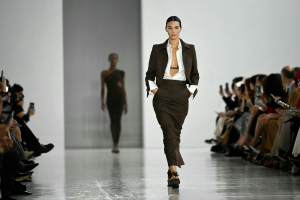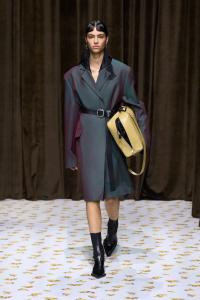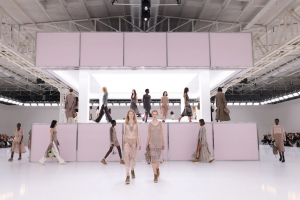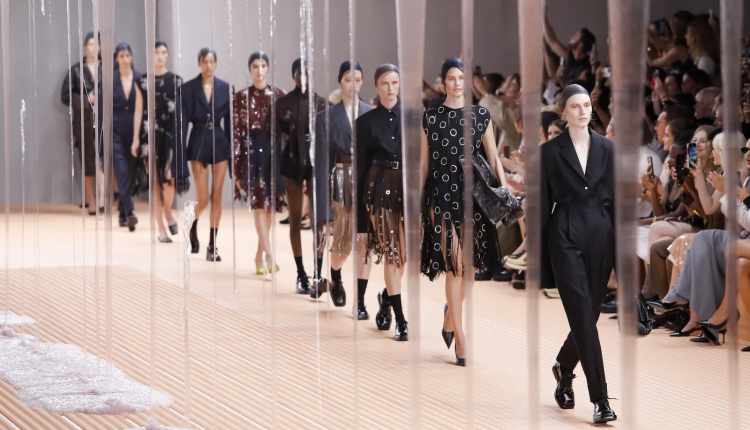Milan Fashion Week 2024: Where Dreams and Realities Collide
Highlights from Milan Fashion Week
Milan Fashion Week 2024 unfolded in a whirlwind of creativity, contrasting ideas, and a bold confrontation between vision and reality. As one of the “Big Four” fashion weeks, Milan has long been a platform where designers experiment with the avant-garde while balancing consumer expectations. This year, that balancing act took center stage more than ever. While the world grapples with uncertainty—from global warming to shifting economic dynamics—fashion’s role is constantly evolving. Is it a tool for escapism, or a mirror reflecting societal changes? In Milan, these questions were presented in dazzling displays of both fantasy and practicality.
Designers like Prada and Max Mara showcased their interpretations of fashion’s future, with vastly different approaches. The bold, superhero-inspired silhouettes at Prada set the stage for a more imaginative, otherworldly fashion narrative. Meanwhile, Max Mara’s minimalist, geometrically precise collection rooted itself in timelessness and restraint. The diversity in Milan’s runway shows reflects not only the creative contrasts among designers but also fashion’s struggle to balance art with commerce, fantasy with functionality.
Beyond the clothes, there’s a deeper conversation unfolding about where the fashion industry is headed. The tension between pushing boundaries and catering to consumer needs has never been more palpable. With global trends focusing on sustainability, inclusivity, and practicality, Milan Fashion Week left many wondering: Can fashion remain relevant while staying true to its artistic roots?
Superheroes in Sci-Fi Shades with Prada
Prada’s runway show was nothing short of a spectacle. The collection seemed to blur the line between fashion and costume, as models paraded down the runway dressed like characters from a futuristic comic book. Sharp lines, metallic fabrics, and oversized sunglasses that looked like something out of a dystopian film gave the collection an undeniable sci-fi edge.
This wasn’t Prada’s first venture into the futuristic. The brand has often been at the forefront of innovation, whether through its designs, collaborations, or even the materials it uses. But this season, the stakes felt higher. As the world faces a technological revolution with AI, climate tech, and digital spaces expanding, Prada seems to be making a statement: fashion must evolve alongside technology, embracing the surreal and the unknown.
But while the collection was visually arresting, it left many wondering about its wearability. Who are these clothes for? Can they find a place in the everyday wardrobe, or are they meant solely for editorial shoots and red carpets? The conversation around practicality versus artistry in fashion has been ongoing, but in a world where people are increasingly conscious of sustainability, the question of whether fashion needs to be wearable is more important than ever.
That being said, Prada’s sci-fi superheroes spoke to a generation that’s looking for strength and empowerment. In a world filled with uncertainty, there’s a desire to feel bold and invincible. Prada tapped into that, offering a wardrobe for those who want to stand out, even if the clothes themselves feel like they’re from another dimension.
Art Versus Function in a Tale of Two Shows
At Milan Fashion Week, there was a clear divide between designers who leaned into the realm of pure artistry and those who prioritized function. This season, we saw two starkly different approaches: some designers, like Prada, who embraced the fantastical, and others who opted for practicality and everyday appeal.
On one side of the spectrum, fashion became a form of artistic expression. Fabrics were sculpted into unrecognizable forms, colors clashed intentionally, and proportions were exaggerated to the point where garments became art pieces rather than functional items. These collections seemed to question whether fashion should always be about utility or whether its role is to provoke thought and inspire creativity.
On the other hand, several designers, such as Max Mara, leaned into functionality. Their collections were full of streamlined silhouettes, neutral color palettes, and high-quality fabrics meant to last. These designers seemed to acknowledge that, for many consumers, fashion needs to serve a purpose. In a post-pandemic world where people are looking to simplify their lives, this focus on practicality is understandable. With remote work and a renewed emphasis on comfort, fashion must strike a balance between looking good and being functional.
This tension between art and function was perhaps best exemplified by the materials used this season. Sustainability remains at the forefront of the industry, and many designers are grappling with how to incorporate eco-friendly fabrics without sacrificing the artistry that makes high fashion so exciting. Some collections managed to achieve this balance, while others fell short, highlighting just how difficult it is to make fashion both sustainable and cutting-edge.
When Less is More at Max Mara
Continuing their theme of simplicity, Max Mara proved that less truly can be more. In an industry that often celebrates extravagance, this collection was a breath of fresh air. The pieces were understated but impeccably crafted, with each garment serving a purpose rather than merely being decorative.

This season, the focus was clearly on craftsmanship. Every stitch seemed deliberate, every fold of fabric intentional. It was a reminder that fashion doesn’t always have to shout to be heard—sometimes, the quietest voices make the biggest statements. In a world that’s increasingly looking for sustainability, this minimalist approach feels more relevant than ever.
Max Mara’s collection is a reflection of where fashion might be headed: towards a more thoughtful, considered approach. In an era of fast fashion and disposable trends, Max Mara’s restraint feels like a return to fashion’s roots. The emphasis is not on producing as much as possible but on creating something that will last. And in that sense, their collection feels not only timeless but also ahead of its time.
Urban Mystique and Jil Sander’s Vision
At Milan Fashion Week, Jil Sander’s latest collection made a powerful statement by drawing inspiration from the evocative work of Canadian photographer Greg Girard. Held in a moody, velvet-draped warehouse, the presentation was a visual and emotional exploration of urban nightlife and transformation.
Lucie and Luke Meier, the creative minds behind Jil Sander, crafted a collection that reflected Girard’s focus on the darker corners of Asian cities. The garments featured an eclectic mix, including iridescent tailoring, cowboy denim, and floral-adorned vinyl overcoats. This eclecticism evoked a blend of “romantic seediness” and “urban sophistication,” mirroring the diverse scenes captured by Girard. The final touch of the collection involved showcasing his photographs on the garments themselves, merging the visual with the tactile in a statement of artistic synergy.

A Centennial Tribute by Fendi
Kim Jones’ Fendi collection for S/S 2025 was a celebration of the house’s centenary. Presented on a grand soundstage outside Milan, the collection paid tribute to the 1920s, reflecting the era’s liberated modernity through a feminine lens.
The show featured diaphanous, flapper-inspired dresses and sheer layers adorned with crystal embellishments. Jones drew inspiration from the intersection of historical and contemporary aesthetics, aiming to bridge the elegance of the 1920s with modern design sensibilities. The runway set, with its futuristic white box, served as a backdrop to a collection that mixed periods and styles, underlined by a soundtrack blending Max Richter’s composition with archival conversations from the Fendi family.

Missing Names and Emerging Talents
This season’s Milan Fashion Week was also notable for the absence of some major names. Tom Ford, under the creative direction of Haider Ackermann, will not present until next year, and Giorgio Armani will showcase his collection in New York as part of his 90th birthday celebrations. MSGM and Blumarine also missed the lineup, with MSGM opting for a more intimate presentation at its headquarters and Blumarine preparing for a debut collection under new creative direction by David Koma.
In a turn towards emerging talent, Central Saint Martins graduate Susan Fang received support from Dolce & Gabbana to present her latest collection. Fang’s show was a refreshing addition to the week, highlighting the festival’s commitment to nurturing new voices in fashion.
Key Trends and Observations
Milan Fashion Week S/S 2025 showcased several key trends:
- Historical References: Designers like Fendi and No. 21 drew inspiration from historical periods, with Fendi focusing on the 1920s and No. 21 channeling the rebellious 1960s. This trend highlights a fascination with how past aesthetics can inform contemporary fashion.
- Eclecticism and Playfulness: The collections from Jil Sander and No. 21 featured a mix of styles and textures, emphasizing a playful approach to fashion that blends different influences.
- Theatrical Presentations: Marni’s show, with its theatrical setup and performance elements, underscored a growing trend towards integrating live performance with fashion presentations.
- Sustainability and Innovation: Although not explicitly highlighted in all collections, there was an undercurrent of sustainability and innovation, particularly in the choice of materials and design philosophies.
Milan’s Fashion Future in the Spotlight
As the final model left the runway and the lights dimmed on Milan Fashion Week 2024, the conversation about fashion’s future only intensified. What direction will the industry take in the years to come? Is the future of fashion rooted in bold, imaginative statements like Prada’s, or will it lean more towards the quiet simplicity and functionality seen at Max Mara?
The world of fashion is at a crossroads. With growing awareness of sustainability, inclusivity, and ethical production, the industry must navigate a new set of challenges. Consumers are increasingly demanding transparency, and the days of endless consumption and fast fashion may be numbered. Milan Fashion Week gave us a glimpse of both extremes—artistic vision and functional simplicity—but left us without clear answers.
One thing is certain: fashion will continue to evolve, reflecting the complexities and contradictions of the world we live in. Whether that evolution leans towards fantasy or practicality remains to be seen, but if Milan Fashion Week is any indication, the future of fashion will be as diverse, dynamic, and thought-provoking as ever.
As the fashion industry moves forward, the role of technology cannot be ignored. With advancements in AI, 3D printing, and even virtual fashion shows, designers are no longer limited by traditional means of production. The intersection of fashion and tech is creating new possibilities for innovation, from sustainable fabric alternatives to digital-only clothing. This shift isn’t just changing how clothes are made—it’s transforming how consumers experience fashion. As digital spaces like the metaverse grow, we may soon see fashion transcend physical boundaries entirely, offering endless opportunities for creativity and personal expression.

